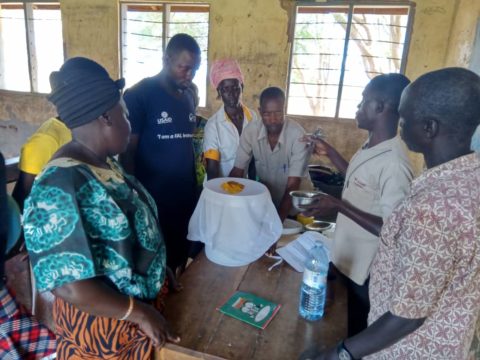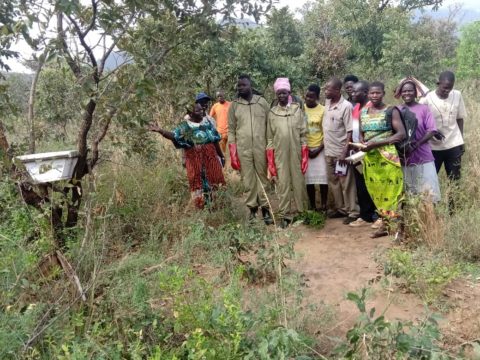Wetlands International is supporting 30 smallholder farmers from upper Aswa-Agago sub-catchment in Abim District, Northern Uganda, to boost their beekeeping to commercial level with a view of improving their livelihoods and building resilience. To kick start this initiative, a one-week practical training exercise has been conducted by three apiculture experts from the private sector. This will help the beekeepers to grasp the current concepts and practices of commercial beekeeping, with experiences drawn from numerous projects in Uganda and beyond.
Following the exercise, each trainee will be equipped with ten baited Kenya Top-Bar Hives (KTBH), ten metallic stands and other assorted beekeeping materials. In addition, technical assistance for hive installation and post-training follow-up visits will be done. These type of hives offer cost-effective intermediate technology with yields that may rival others available in the market.

Training on hygienic honey filtering process using affordable and locally available materials
Drawn from Angaro, Loyoroit and Odongi micro-catchments that cover 611 square kilometres in three sub counties of Lotuke, Alerek and Abim respectively, a total of 100 beekeepers were selected from three beekeeping associations. From these, thirty individual beneficiaries – 14 women and 16 men – were organised in three clusters under three champions, each linked to nine other beekeepers. The selection process included engaging the community members with emphasis on women and youth who are keen on commercial beekeeping. Also scoped were key challenges and opportunities involved in the uptake of agricultural interventions such as beekeeping in the Karamoja region.

Field session on apiary selection, installation and management as well as protection from predators and pests
Building on the indigenous knowledge, the groups have been trained on beekeeping practices, use of different beekeeping equipment and honey harvesting kits, value addition to honey and other bee products such as beeswax, propolis and bee venom as well as market access.
A critical success factor is the supervision of the beneficiaries. The training model includes mentoring and coaching where each champion and their cluster of nine beekeepers work together in sharing skills, knowledge and materials, where necessary. This network is envisaged to gradually grow as the nine beekeepers also graduate into champions. There are also plans to develop partnerships with the private sector that will act as a catalyst to the entire process to guarantee sustainability.
Honey production and honey hunting is part of the ancestry of communities in Karamoja sub-region; but commercial beekeeping is still at its infancy. Men make traditional log hives from indigenous trees in the forests particularly in the hillsides. Beekeeping is a highly promising livelihood venture owing to the naturally occurring large bee population particularly in the hundreds of hills and forests all across this region.

An abandoned traditional hive
The initiative is part of the three-year Ecosystem-based Disaster Risk Reduction (Eco-DRR) project that uses an Integrated Risk Management (IRM) approach involving ecosystem management and restoration, climate change adaptation and mitigation, and disaster risk reduction while mainstreaming gender in all its activities. The project was awarded by the European Commission to the UN Environment Programme (UNEP), in collaboration with Partners for Resilience (PfR) represented by the Netherlands Red Cross, to focus on scaling-up Eco-DRR interventions and promote large scale implementation of Eco-DRR.
Lead photo: Meeting with select beekeepers in preparation for the training
